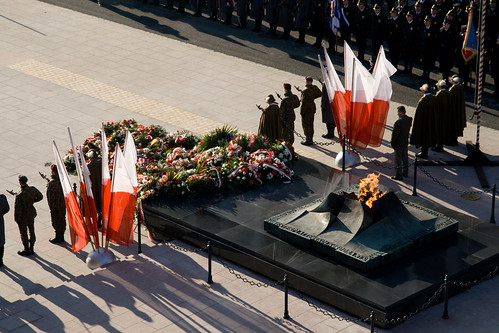Dzień Niepodległości:) Posted by Kasia on Nov 11, 2014 in Culture
Poland’s National Independence Day (Dzień Niepodległości) marks the anniversary of the country’s independence in 1918. It is celebrated as a nationwide holiday on November 11 each year.
Ceremonious gatherings and parades (uroczyste spotkania i parady) are held in Polish towns and cities, including at Piłsudski Square in Warsaw. A change of guards (zmiana strażników) also occurs at midday near the Tomb of the Unknown Soldier (Grób Nieznanego Żołnierza) in the capital city. Many churches celebrate Independence Day with a special mass. Another highlight is the Race of Independence, which involves thousands of participants.
Independence Day is an official public holiday in Poland, so schools, banks, government offices and most private businesses are closed. There is a trade prohibition on public holidays in Poland. People intending to travel via public transport during public holidays must check with the public transit authorities on any changes to time schedules.
Poland regained its independence on November 11, 1918, after 123 years of partitions by Austria-Hungary, Germany, and Russia. On November 11, 1918, the Polish Military Organization’s secret departments, demobilized soldiers, and legionnaires disarmed the Germans in Warsaw and other Polish towns. The Regency Government appointed Józef Piłsudski as commander in chief over the Polish forces and 3 days later he was given complete civil control. He formed a new centralized government which on November 21 issued key measures including a manifesto of agricultural reforms. Pilsudski also brought in more favorable conditions for the workers and called parliamentary elections.
November 11 was announced a national holiday in 1937. However, it was removed as an official holiday from 1939 to 1989. The holiday was restored in 1989 and has since been a national public holiday.
Many houses, buildings, buses and trams display Polish flags on Independence Day. The Polish flag has 2 horizontal stripes of equal width and height – the upper stripe is white and the lower one is red. It was officially recognized in 1919, one year after Poland’s independence was regained.
Józef Pilsudski and George Washington – The Right Men at the Right Time?
Both Piłsudski and Washington played critical pivotal roles (krytyczne kluczowe role) for Poland and the United States, respectively, when Poland on November 11, 1918 and the United States on July 4, 1776 declared their existence as independent political states. They were both commanders-in-chief of their nation’s army and would lead their nations in peacetime. The ultimate survival of a nation rests on its military leadership and the willingness of the people to support them.
In the cases of the United States about 30% of the civilian population supported England and 30% were neutral. In the case of Poland the vast majority of civilians and those Poles who were fighting during the First World War no longer wished to be cannon fodder for the Russians, the Germans or the Austro-Hungarian Empires. Virtually the entire population was tired of being exploited. They were determined to end the exploitation. There was no other choice on the table.
Each of them, both Piłsudski and Washington, was the right person at the right time. Thanks to them and those they led, today we have a strong Poland and United States of America.
Do następnego razu… (Till next time…)

Build vocabulary, practice pronunciation, and more with Transparent Language Online. Available anytime, anywhere, on any device.
About the Author: Kasia
My name is Kasia Scontsas. I grew near Lublin, Poland and moved to Warsaw to study International Business. I have passion for languages: any languages! Currently I live in New Hampshire. I enjoy skiing, kayaking, biking and paddle boarding. My husband speaks a little Polish, but our daughters are fluent in it! I wanted to make sure that they can communicate with their Polish relatives in our native language. Teaching them Polish since they were born was the best thing I could have given them! I have been writing about learning Polish language and culture for Transparent Language’s Polish Blog since 2010.





Comments:
barbara:
Hello Kasia, I read your post and I find them very interesting. I’am from Philadelphia , born and raised. My mother was Polish and spoke to us in Polish when we were young. I wish she would have kept teaching us as we got older.
I have my Grandfathers Naturalizations papers when he first came to the USA and have to check the town where he came from. My mother was the youngest of 6 and all her siblings have died. I would like to know if I have relatives that are living in Poland . Hope to talk to you again.
Artur:
It is customary to say ‘zmiana warty’ rather than ‘zmiana strażników’.